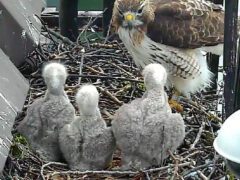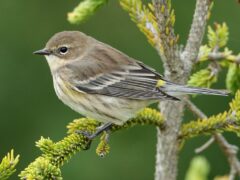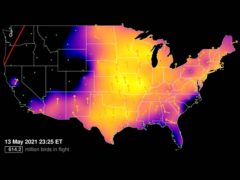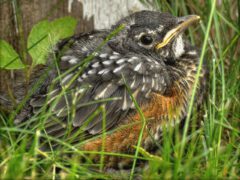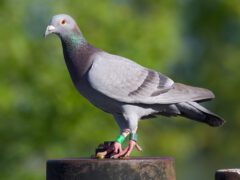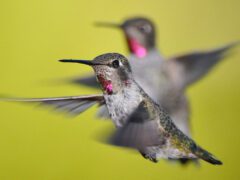Laughing Gull Similar Species Comparison
Main SpeciesLaughing Gull
Flock with Herring Gulls
Gathers in large groups when food is abundant, such as eggs from horseshoe crabs. Gives frequent loud, shrill cries.
© Timothy Barksdale / Macaulay LibraryNew Jersey, May 01, 1998Habitat
Found in groups in beaches, salt marshes, mangroves, or on agricultural fields or landfills near the coast.
© Mary Harrell / Macaulay LibraryFlorida, May 07, 2017Breeding adult
Medium-sized gull with a thin and slightly drooping bill. Breeding adults have a black head, thin white eye crescents, and a red bill.
© Dorian Anderson / Macaulay LibraryAlabama, April 21, 2019Nonbreeding adult
Nonbreeding adults have a bit of black smudging behind the eye, but are otherwise white with a medium gray back. Note the small white spots on the primaries.
© Paul Tavares / Macaulay LibrarySouth Carolina, September 22, 2014Breeding adults
Medium-sized gull with dark hood and dark gray back. Commonly forages with other species of gulls, terns, and shorebirds.
© Larry Arbanas / Macaulay LibraryTexasJuvenile
Medium-sized gull with a thin, slightly drooping bill. Juveniles are brownish, paler on the head and neck, with white eye crescents.
© Max McCarthy / Macaulay LibraryNew Jersey, August 09, 2017First winter
First winter gulls are starting to acquire gray feathers on their back and wings. The head and neck remains gray and smudgy. Note slightly drooping bill and dark primaries.
© James (Jim) Holmes / Macaulay LibraryYucatán, January 13, 2017Breeding adult at nest
Nests on sand, typically near or under vegetation, where eggs can be very difficult to see. In hot sun, gulls and other birds open their bills and pant to cool off.
© Benjamin Clock / Macaulay LibraryLouisiana, June 17, 2010Second winter
Second winter gulls have a gray wash on their neck and chest with darker gray smudging on the head.
© Alix d'Entremont / Macaulay LibraryNova Scotia, November 16, 2014Breeding adult
In flight, note the dark underside of the primaries on breeding adults
© John C Sullivan / Macaulay LibraryOregon, April 13, 2017Breeding adults
This bird's crouching posture while running with partially spread wings is a display intended to signal aggression or to claim ownership of a space.
© Timothy Barksdale / Macaulay LibraryTexas, March 04, 1997First winter
First winter gulls in flight show dark primaries and a wide dark tail band.
© James Rieman / Macaulay LibraryTexas, September 17, 2017Nonbreeding adult
Nonbreeding adults are mostly white and gray with a bit of gray smudging on the head above and behind the eye. Note the dark primaries with little to no white spots on the folding wings.
© Jonathan Eckerson / Macaulay LibraryMassachusetts, September 30, 2016Flock with Herring Gulls
Gathers in large groups when food is abundant, such as eggs from horseshoe crabs. Gives frequent loud, shrill cries.
© Timothy Barksdale / Macaulay LibraryNew Jersey, May 01, 1998Habitat
Found in groups in beaches, salt marshes, mangroves, or on agricultural fields or landfills near the coast.
© Mary Harrell / Macaulay LibraryFlorida, May 07, 2017Breeding adult
Medium-sized gull with a thin and slightly drooping bill. Breeding adults have a black head, thin white eye crescents, and a red bill.
© Dorian Anderson / Macaulay LibraryAlabama, April 21, 2019Nonbreeding adult
Nonbreeding adults have a bit of black smudging behind the eye, but are otherwise white with a medium gray back. Note the small white spots on the primaries.
© Paul Tavares / Macaulay LibrarySouth Carolina, September 22, 2014Breeding adults
Medium-sized gull with dark hood and dark gray back. Commonly forages with other species of gulls, terns, and shorebirds.
© Larry Arbanas / Macaulay LibraryTexasJuvenile
Medium-sized gull with a thin, slightly drooping bill. Juveniles are brownish, paler on the head and neck, with white eye crescents.
© Max McCarthy / Macaulay LibraryNew Jersey, August 09, 2017First winter
First winter gulls are starting to acquire gray feathers on their back and wings. The head and neck remains gray and smudgy. Note slightly drooping bill and dark primaries.
© James (Jim) Holmes / Macaulay LibraryYucatán, January 13, 2017Breeding adult at nest
Nests on sand, typically near or under vegetation, where eggs can be very difficult to see. In hot sun, gulls and other birds open their bills and pant to cool off.
© Benjamin Clock / Macaulay LibraryLouisiana, June 17, 2010Second winter
Second winter gulls have a gray wash on their neck and chest with darker gray smudging on the head.
© Alix d'Entremont / Macaulay LibraryNova Scotia, November 16, 2014Breeding adult
In flight, note the dark underside of the primaries on breeding adults
© John C Sullivan / Macaulay LibraryOregon, April 13, 2017Breeding adults
This bird's crouching posture while running with partially spread wings is a display intended to signal aggression or to claim ownership of a space.
© Timothy Barksdale / Macaulay LibraryTexas, March 04, 1997First winter
First winter gulls in flight show dark primaries and a wide dark tail band.
© James Rieman / Macaulay LibraryTexas, September 17, 2017Nonbreeding adult
Nonbreeding adults are mostly white and gray with a bit of gray smudging on the head above and behind the eye. Note the dark primaries with little to no white spots on the folding wings.
© Jonathan Eckerson / Macaulay LibraryMassachusetts, September 30, 2016Flock with Herring Gulls
Gathers in large groups when food is abundant, such as eggs from horseshoe crabs. Gives frequent loud, shrill cries.
© Timothy Barksdale / Macaulay LibraryNew Jersey, May 01, 1998Habitat
Found in groups in beaches, salt marshes, mangroves, or on agricultural fields or landfills near the coast.
© Mary Harrell / Macaulay LibraryFlorida, May 07, 2017Similar SpeciesBlack-headed Gull
Breeding adult
Breeding Black-headed Gulls have a browner head and thinner eye arcs compared to Laughing Gulls.
© Paul Tavares / Macaulay LibrarySuðurland, July 06, 2011Similar SpeciesBlack-headed Gull
Nonbreeding adult
Black-headed Gulls have a white leading edge on the primaries that is visible in flight that Laughing Gulls lack.
© Aidan Rominger / Macaulay LibraryOhio, January 09, 2016Similar SpeciesFranklin's Gull
Breeding adult
Breeding Franklin's Gulls can be separated from Laughing Gulls by their thicker eye crescents, straighter bill, and larger white spots on the primaries.
© Brad Argue / Macaulay LibraryHawaii, May 21, 2016Similar SpeciesFranklin's Gull
First winter
The back of the neck on first winter Franklin's Gulls is whiter than it is on first winter Laughing Gulls. The tail band is also narrower on Franklins. The underwing pattern (not visible in this photos) is clean on Franklin's, but mottled on Laughing.
© Brian Sullivan / Macaulay LibraryGuanacaste, November 11, 2008Similar SpeciesFranklin's Gull
Nonbreeding adult
Nonbreeding adult Franklin's Gulls have more white in the primaries than nonbreeding adult Laughing Gulls. Note especially the white band in between the dark wing tips on Franklin's, but not on Laughing.
© Brian Sullivan / Macaulay LibraryGuanacaste, November 11, 2008Similar SpeciesBonaparte's Gull
Breeding adult
Breeding adult Bonaparte's Gulls have a thinner black bill than breeding adult Laughing Gulls, which have a thicker red bill.
© Yvonne Bieman / Macaulay LibraryOntario, July 23, 2017Similar SpeciesBonaparte's Gull
Nonbreeding adult
Nonbreeding adult Bonaparte's Gulls have a distinct dark spot behind their eye that nonbreeding adult Laughing Gulls lack; they have a smudgy spot above the eye. Also note the thinner bill and pink legs on Bonaparte's Gulls.
© Evan Lipton / Macaulay LibraryMassachusetts, November 03, 2016Similar SpeciesLittle Gull
Adult breeding
Breeding and nonbreeding adult Little Gulls have dark underwings unlike Laughing Gulls, which have pale underwings.
© Ian Davies / Macaulay LibrarySouth Karelia, June 07, 2015Similar SpeciesLesser Black-backed Gull
Nonbreeding adult
Nonbreeding adult Lesser Black-backed Gulls are larger than Laughing Gulls with a yellow bill and yellow legs.
© Dorian Anderson / Macaulay LibraryFlorida, February 25, 2015Similar SpeciesLesser Black-backed Gull
Juvenile
Juvenile Lesser Black-backed Gulls are heftier than juvenile Laughing Gulls with a bigger bill. They are also darker brown overall and don't have the Laughing Gull's eye crescents.
© Jeremiah Trimble / Macaulay LibraryMassachusetts, December 10, 2011Similar SpeciesAmerican Herring Gull
Second winter
American Herring Gulls are larger than Laughing Gulls with pink (not dark) legs. Second winter American Herring Gulls have a bicolored bill whereas Laughing Gulls of all ages have an entirely dark bill.
© Chris Wood / Macaulay LibraryNew York, November 08, 2015Similar SpeciesAmerican Herring Gull
Juvenile
American Herring Gulls are larger than Laughing Gulls with pink (not dark) legs. Juveniles are tan overall with a tan-and-white checkerboard pattern on their back unlike juvenile Laughing Gulls that have more of a scalloped pattern on their back.
© Evan Lipton / Macaulay LibraryMassachusetts, August 06, 2014Similar SpeciesRing-billed Gull
First winter
First winter Ring-billed Gulls have a pink bill with a black tip, whereas Laughing Gulls in all ages have a black bill.
© Brad Walker / Macaulay LibraryNew York, February 27, 2016Similar SpeciesBlack-headed Gull
Breeding adult
Breeding Black-headed Gulls have a browner head and thinner eye arcs compared to Laughing Gulls.
© Paul Tavares / Macaulay LibrarySuðurland, July 06, 2011Similar SpeciesBlack-headed Gull
Nonbreeding adult
Black-headed Gulls have a white leading edge on the primaries that is visible in flight that Laughing Gulls lack.
© Aidan Rominger / Macaulay LibraryOhio, January 09, 2016Similar SpeciesFranklin's Gull
Breeding adult
Breeding Franklin's Gulls can be separated from Laughing Gulls by their thicker eye crescents, straighter bill, and larger white spots on the primaries.
© Brad Argue / Macaulay LibraryHawaii, May 21, 2016Similar SpeciesFranklin's Gull
First winter
The back of the neck on first winter Franklin's Gulls is whiter than it is on first winter Laughing Gulls. The tail band is also narrower on Franklins. The underwing pattern (not visible in this photos) is clean on Franklin's, but mottled on Laughing.
© Brian Sullivan / Macaulay LibraryGuanacaste, November 11, 2008Similar SpeciesFranklin's Gull
Nonbreeding adult
Nonbreeding adult Franklin's Gulls have more white in the primaries than nonbreeding adult Laughing Gulls. Note especially the white band in between the dark wing tips on Franklin's, but not on Laughing.
© Brian Sullivan / Macaulay LibraryGuanacaste, November 11, 2008Similar SpeciesBonaparte's Gull
Breeding adult
Breeding adult Bonaparte's Gulls have a thinner black bill than breeding adult Laughing Gulls, which have a thicker red bill.
© Yvonne Bieman / Macaulay LibraryOntario, July 23, 2017Similar SpeciesBonaparte's Gull
Nonbreeding adult
Nonbreeding adult Bonaparte's Gulls have a distinct dark spot behind their eye that nonbreeding adult Laughing Gulls lack; they have a smudgy spot above the eye. Also note the thinner bill and pink legs on Bonaparte's Gulls.
© Evan Lipton / Macaulay LibraryMassachusetts, November 03, 2016Similar SpeciesLittle Gull
Adult breeding
Breeding and nonbreeding adult Little Gulls have dark underwings unlike Laughing Gulls, which have pale underwings.
© Ian Davies / Macaulay LibrarySouth Karelia, June 07, 2015Similar SpeciesLesser Black-backed Gull
Nonbreeding adult
Nonbreeding adult Lesser Black-backed Gulls are larger than Laughing Gulls with a yellow bill and yellow legs.
© Dorian Anderson / Macaulay LibraryFlorida, February 25, 2015Similar SpeciesLesser Black-backed Gull
Juvenile
Juvenile Lesser Black-backed Gulls are heftier than juvenile Laughing Gulls with a bigger bill. They are also darker brown overall and don't have the Laughing Gull's eye crescents.
© Jeremiah Trimble / Macaulay LibraryMassachusetts, December 10, 2011Similar SpeciesAmerican Herring Gull
Second winter
American Herring Gulls are larger than Laughing Gulls with pink (not dark) legs. Second winter American Herring Gulls have a bicolored bill whereas Laughing Gulls of all ages have an entirely dark bill.
© Chris Wood / Macaulay LibraryNew York, November 08, 2015Similar SpeciesAmerican Herring Gull
Juvenile
American Herring Gulls are larger than Laughing Gulls with pink (not dark) legs. Juveniles are tan overall with a tan-and-white checkerboard pattern on their back unlike juvenile Laughing Gulls that have more of a scalloped pattern on their back.
© Evan Lipton / Macaulay LibraryMassachusetts, August 06, 2014Similar SpeciesRing-billed Gull
First winter
First winter Ring-billed Gulls have a pink bill with a black tip, whereas Laughing Gulls in all ages have a black bill.
© Brad Walker / Macaulay LibraryNew York, February 27, 2016Similar SpeciesBlack-headed Gull
Breeding adult
Breeding Black-headed Gulls have a browner head and thinner eye arcs compared to Laughing Gulls.
© Paul Tavares / Macaulay LibrarySuðurland, July 06, 2011Similar SpeciesBlack-headed Gull
Nonbreeding adult
Black-headed Gulls have a white leading edge on the primaries that is visible in flight that Laughing Gulls lack.
© Aidan Rominger / Macaulay LibraryOhio, January 09, 2016Species in This Family
Gulls, Terns, and Skimmers(Order: Charadriiformes, Family: Laridae)


































